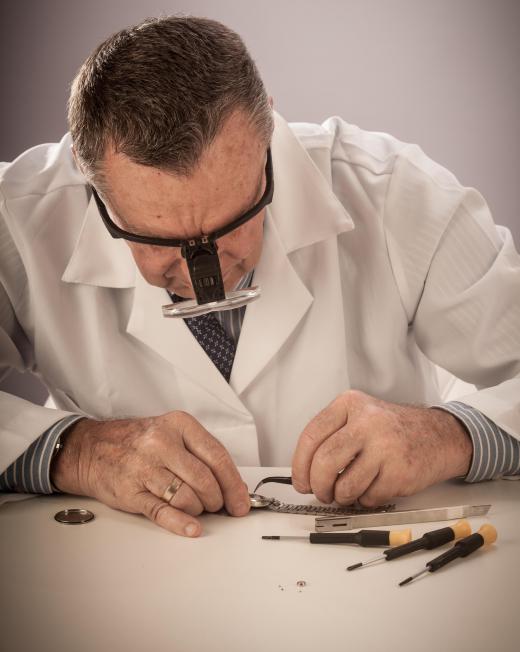What is a Vibrograph?
 Mary McMahon
Mary McMahon
A vibrograph is a device which detects vibrations and charts them. These devices can be used in a number of different settings, and some creative individuals have even made their own for specialty projects. Numerous companies manufacture vibrographs for various applications, and they are available for sale through suppliers of scientific equipment, as well as directly through some manufacturers. Many manufacturers can also create custom equipment for specialized applications by request from customers.
One use for a vibrograph is in horology. When people work on watches and clocks, they can use a vibrograph to check accuracy. The device logs every tick, as well as other vibrations generated, and this data can be used to determine how accurate the timekeeping device is. Using a vibrograph, it's possible to extrapolate accuracy over a period of months or years. These devices are used to check on new watches, to confirm that repairs are satisfactory, and to gather information about a watch which needs repair before repairs begin.

Another use for vibrographs is in equipment monitoring. A vibrograph can be attached to a piece of equipment to provide data about the vibrations made by the equipment. Abnormalities can indicate that there is a problem such as too much pressure, a loose part, or a part which is about to break. The vibrograph can be used to catch problems before a human operator notices them, potentially saving on costly repairs by allowing issues to be addressed quickly. The device can also be used to check on the performance of a piece of equipment which appears to be faulty.
Vibrographs are also used to monitor vibrations at a site. In a vibrograph survey, a vibrograph is left at a site for a set period to record all vibrations. This can be useful for determining whether or not vibrations are occurring in a range which could be dangerous. For example, construction might threaten a historic building by subjecting it to intense vibrations. A vibrograph could be used to confirm that vibrations are in a safe range when crews work on roads, new buildings, and so forth.
There are other applications in which it might be useful to collect information about vibrations. Mining and other industries which use explosives sometimes utilize these machines to monitor safety and to confirm that charges are placed in the right location, for example. Vibrograph surveys can also provide information about the impacts of geologic activity, construction, passing vehicles, and so forth when people are studying fragile environments and structures.
AS FEATURED ON:
AS FEATURED ON:











Discussion Comments
@NathanG - Scientists do monitor the ocean floor. I don’t know the exact technology used, or how this fits into the scheme of things, but I do know that they use something similar to sonar technology, where they can bounce signals from the ocean surface down to the ocean floor and listen in that way. I don’t think any devices need to be deployed at the ocean floor as such.
I think an obvious application for the vibrograph is to detect the initial rumblings of an earthquake, or even slight tremors that might precede it.
I believe that scientists have this technology in place already as I know that they do monitor the fault lines along the Earth’s crust. What I don’t know is if they use a vibrograph as such, or something like it.
I’d be curious to know how such technology could be adapted for oceanographic purposes. Perhaps they could deploy these devices along the ocean floor to constantly listen in for the slightest anomalies in the Earth’s vibrations. That would provide forewarning that an earthquake, and possible a tsunami, was on its way.
Where can I purchase a vibrograph? I can't ever recall seeing one in one of the big electronics stores.
Also, If I do choose to purchase one, what kinds of things should I look out for and how much can I expect to pay? I'm still not entirely sure what I will do with one of these once I get it so I probably don't need the nicest model ever made but I would still like to get one that is not going to fall apart on me.
A good friend of mine is really handy and creative and he made an instrument that is based around a vibrograph.
It works like this. Two clips that run from the vibrograph are clipped onto an object. It can be just about any object, but the less dense the better. Once the machine is hooked up, the vibrograph registers all the vibrations every time the object is touched. It then translates these vibrations into sounds which can be varied according to the users needs.
It is pretty incredible to see. The first time he showed it to me he hooked it up to a fern and proceeded to play the plant. It does not makes a range of tones as varied as a violin or a trumpet, but it is fun to see and there is lots of potential.
Post your comments